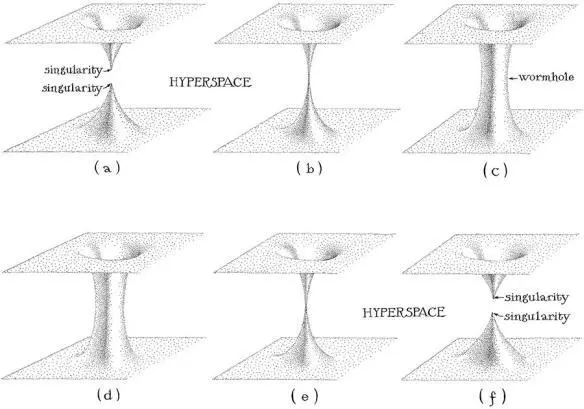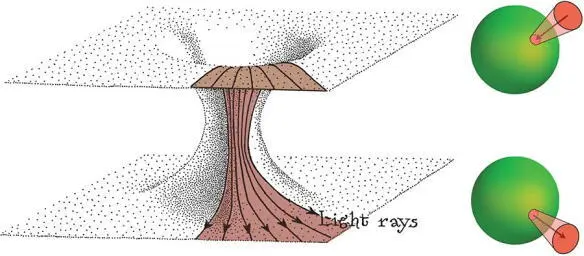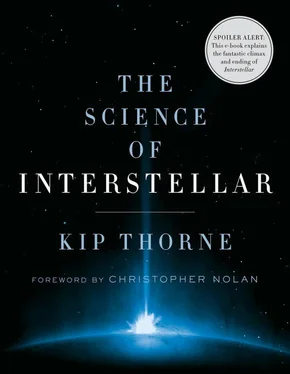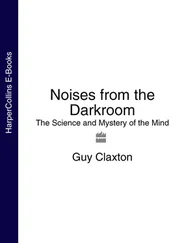Of course, our universe is really three dimensional. The concentric circles in the left part of Figure 14.2 are really the nested green spheres shown to the right. As you enter the wormhole along the blue path from location A , you pass through spheres that get smaller and smaller. Then the spheres, though nested inside each other, cease changing circumference. And then, as you exit the wormhole toward location B , the spheres get larger and larger.
For nineteen years, physicists paid little attention to Flamm’s outrageous solution of Einstein’s equations, his wormhole. Then in 1935 Einstein himself and fellow physicist Nathan Rosen, unaware of Flamm’s work, rediscovered Flamm’s solution, explored its properties, and speculated about its significance in the real world. Other physicists, also unaware of Flamm’s work, began to call his wormhole the “Einstein-Rosen bridge.”

Fig. 14.2. Flamm’s wormhole.
Wormhole Collapse

It is often difficult to extract, from the mathematics of Einstein’s equations, a full understanding of their predictions. Flamm’s wormhole is a remarkable example. From 1916 until 1962, nearly a half century, physicists thought that the wormhole is static, forever unchanging. Then John Wheeler and his student Robert Fuller discovered otherwise. Looking much more closely at the mathematics, they discovered that the wormhole is born, expands, contracts, and dies, as shown in Figure 14.3.
Initially, in picture (a), our universe has two singularities. As time passes, the singularities reach out to each other through the bulk and meet to create the wormhole (b). The wormhole expands in circumference, (c) and (d), then shrinks and pinches off (e), leaving behind the two singularities (f). The birth, expansion, shrinkage, and pinch-off happen so quickly that nothing, not even light, has time to travel through the wormhole from one side to the other. Anything or anyone that attempts the trip will get destroyed in the pinch-off!

Fig. 14.3. Dynamics of Flamm’s wormhole (the Einstein-Rosen bridge). [Drawing by Matt Zimet based on a sketch by me; from my book Black Holes & Time Warps: Einstein’s Outrageous Legacy .]
This prediction is inescapable. If the universe were ever, somehow, to develop a spherical wormhole that contains no gravitating matter, this is how the wormhole would behave. Einstein’s relativistic laws dictate it.
Wheeler was not dismayed by this conclusion. On the contrary, he was pleased. He regarded singularities (places where space and time are infinitely warped) as a “crisis” for the laws of physics. And crises are wonderful tutors. By probing wisely, we can get great insights into the physical laws. To this I return in Chapter 26.
Contact

Fast-forward a quarter century, to May 1985: a phone call from Carl Sagan asking me to critique the relativistic science in his forthcoming novel Contact . I happily agreed. We were close friends, I thought it would be fun, and, besides, I still owed him one for introducing me to Lynda Obst.
Carl sent me his manuscript. I read it and I loved it. But there was one problem. He sent his heroine, Dr. Eleanor Arroway, through a black hole from our solar system to the star Vega. But I knew that a black-hole interior cannot be a route from here to Vega or to anywhere else in our universe. After plunging through the black hole’s horizon, Dr. Arroway would get killed by its singularity. To reach Vega fast, she needed a wormhole, not a black hole. But a wormhole that does not pinch off. A traversable wormhole.
So I asked myself, What do I have to do to Flamm’s wormhole to save it from pinching off; to hold it open, so it can be traversed? A simple thought experiment gave me the answer.
Suppose you have a wormhole that is spherical like Flamm’s, but unlike Flamm’s it does not pinch off. Send a light beam into the wormhole, radially. Since all the beam’s light rays travel radially, the beam must have the shape shown in Figure 14.4. It is converging (its cross-sectional area is decreasing) as it enters the wormhole, and it is diverging (its area is increasing) as it leaves the wormhole. The wormhole has bent the light rays outward, as would a diverging lens.

Fig. 14.4. A radial light beam traveling through a spherical, traversable wormhole. Left : As seen from the bulk with one space dimension removed. Right : As seen in our universe. [Adapted from a drawing by Matt Zimet based on a sketch by me; from my book Black Holes & Time Warps: Einstein’s Outrageous Legacy .]
Now, gravitating bodies such as the Sun or a black hole bend rays inward (Figure 14.5). They can’t bend rays outward. To bend light rays outward, a body must have negative mass (or equivalently, negative energy; recall Einstein’s equivalence of mass and energy). From this fundamental fact, I concluded that any traversable, spherical wormhole must be threaded by some sort of material that has negative energy. At least the material’s energy must be negative as seen by the light beam, or by anything or anyone else that travels through the wormhole at nearly the speed of light. [27] Energy is weird in relativistic physics; the energy one measures depends on how fast one moves and in what direction.
I call such material “exotic matter.” (I later learned that, according to Einstein’s relativistic laws, any wormhole, spherical or not, is traversable only if it is threaded by exotic matter. This follows from a theorem proved in 1975 by Dennis Gannon at the University of California at Davis. Being somewhat illiterate, I was unaware of Gannon’s theorem.)
Now, it is an amazing fact that exotic matter can exist, thanks to weirdnesses in the laws of quantum physics. Exotic matter has even been made in physicists’ laboratories, in tiny amounts, between two closely spaced electrically conducting plates. This is called the Casimir effect. However, it was very unclear to me in 1985 whether a wormhole can contain enough exotic matter to hold it open. So I did two things.

Fig. 14.5. The Sun or a black hole bends a beam of light inward.
First, I wrote a letter to my friend Carl suggesting that he send Eleanor Arroway to Vega through a wormhole rather than a black hole, and I enclosed a copy of the calculations by which I had shown that the wormhole must be threaded by exotic matter. Carl embraced my suggestion (and wrote about my equations in the acknowledgment of his novel). And that is how wormholes entered modern science fiction—novels, films, and television.
Second, with two of my students, Mark Morris and Ulvi Yurtsever, I published two technical articles about traversable wormholes. In our articles, we challenged our physicist colleagues to figure out whether the combined quantum laws and relativistic laws permit a very advanced civilization to collect enough exotic matter inside a wormhole to hold it open. This triggered a lot of research by a lot of physicists; but today, nearly thirty years later, the answer is still unknown. The preponderance of the evidence suggests that the answer may be NO, so traversable wormholes are impossible. But we are still far from a final answer. For details, check out Time Travel and Warp Drives by my physicist colleagues Allen Everett and Thomas Roman (Everett and Roman 2012).
Читать дальше

















